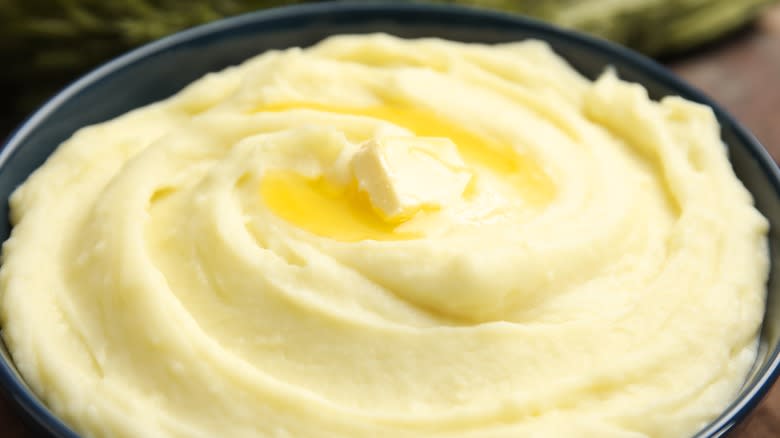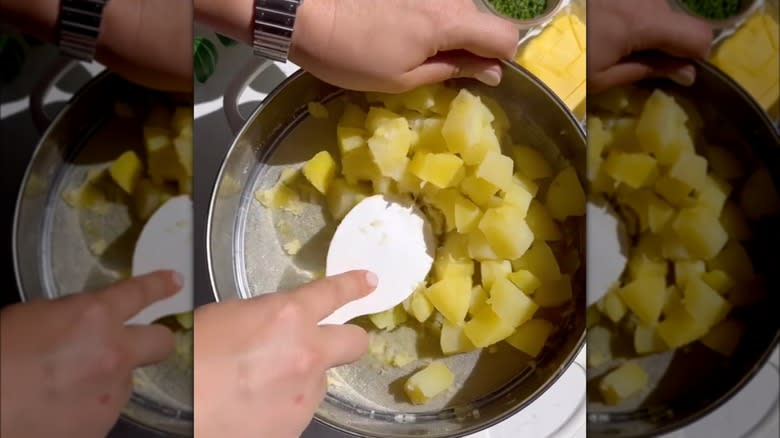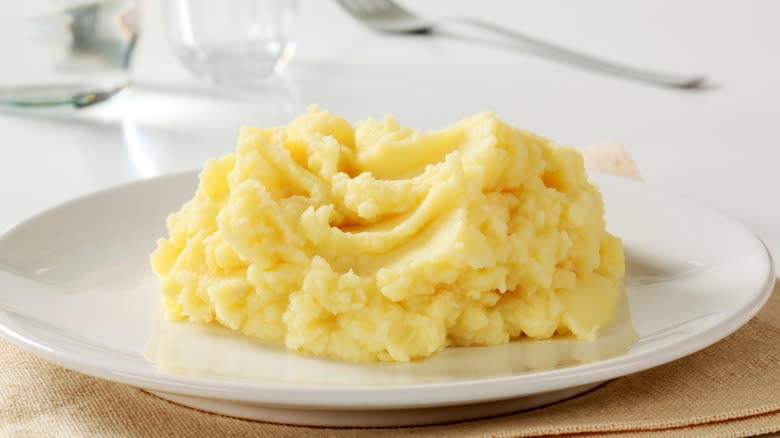A Tamis Is The Old School Tool You Need For Perfect Mashed Potatoes

While the running lumpy mashed potato joke might get old at the holiday table, the inconsistent texture does not make for a pleasant bite. A favorite comfort food, those creamy, sometimes decadent, potatoes satisfy even more when the consistency is velvety smooth. A tamis can be the kitchen tool that perfects that final product.
Transforming that tubular, hard vegetable into a creamy, smooth mashed potato takes more than just brute strength from a masher. Some people use a ricer, hand beater, or manual potato masher to transform the consistency. But, those tools can still leave an errant bigger piece that stands out in the creaminess, like a pothole in the road.
A tamis is basically a fine metal strainer. The large, round, tool looks almost like a spring form pan from a distance. For mashed potatoes, the mixture is placed on the sleeve, and slowly and carefully pushed through the openings. Since the holes are very small, any potato piece is broken. By using a scraper to manipulate the potatoes across the horizontal surface, the process is controlled. It might not be as efficient as a hand beater, but the final product shows the difference in its almost velvety-like puree.
For the mashed potato lover who never wants the disgrace of lumps in that classic recipe, the tamis might be the old-school kitchen tool to perfect that dish. No one has to know the secret to those spuds, unless they want to help cook.
Read more: The Best Kitchen Gadgets You Can Buy
Why Do Chefs Prefer A Tamis For Mashed Potatoes?

From Thomas Keller to Joel Robuchon, their legendary mashed potatoes have one thing in common. They use a tamis to create that luscious, creamy texture. While a tamis alone does not instantly transform a pot of boiled potatoes into the ultimate comfort food, the kitchen tool allows greater control. Instead of a lumpy, rustic side dish, the bite resembles more of a French pomme puree.
The tamis is beneficial for several reasons. It offers a flat, wide surface that can be easily positioned above a pot. A potato masher might miss a corner and a hand beater can over-mix potatoes, leading to a starchy mess. It is a relatively small, easy-to-use device. There is no learning curve or significant purchase cost.
But, using a tamis is a multi-step process. After ricing or processing the potatoes through a food mill, the tamis' fine mesh breaks up any leftover lumps. It does not require a lot of force or effort. Whole potatoes or larger potato pieces do not work with this process because the tamis is more like a final step to break up any lumpy parts.
For the next holiday gathering, do not let the lumps make people grumpy around the table. Use the chef's secret for perfectly smooth mashed potatoes and use a tamis to break up the bumps in the bite.
Is A Tamis Really Worth The Effort For Those Mashed Potatoes?

While mashed potatoes are a relatively simple dish, achieving the preferred texture is not as simple as it seems. Some chefs swear by the velvety smooth texture that a tamis produces, but home cooks might wonder if another kitchen tool and extra step is worth the effort.
By using a tamis, the overall mashed potato texture tends to be denser. However, the method does not produce a gummy result, like over-beating potatoes with a hand mixer does. If airy, light texture is preferred, it is better to use a food mill. This method tends to absorb more butter and cream than the tamis allows. Sometimes flavor takes preference over the texture.
Overall, using a tamis for mashed potatoes is a personal preference. The additional kitchen tool is not costly nor does it take up too much space, plus you can use it for more than just mashed taters. But, if a person likes the lumps, texture, or homey quality of non-homogeneous texture in their food, this technique may not be for them.
Read the original article on Daily Meal.

